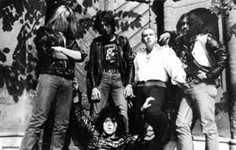Before Briefly Leaving, DPS Mostly Arrested People of Color in East Austin
DPS troopers invited back to town
By Austin Sanders, Fri., June 30, 2023

At a community meeting organized to discuss the partnership between the Texas Department of Public Safety and the Austin Police Department, set to resume July 2, a common sentiment voiced by attendees was the fear and uncertainty felt when living in a neighborhood actively targeted for increased police patrol.
"I'm Black and not a native Austinite, so sometimes I don't know exactly where I'm driving," said Sybil Sybille, who attended the Tuesday, June 27, meeting held at the Virginia Brown Rec Center in Northeast Austin. "I could make one wrong turn and get pulled over."
When she is pulled over, Sybille told the Chronicle, "my heart starts beating fast [because] I don't know how the interaction will go. It doesn't matter that I have my license, my tags are up to date, and I haven't done anything wrong. It's scary."
That experience has been echoed by others living in the East Austin neighborhoods targeted during the first phase of the APD/DPS partnership, which saw 100 state troopers patrolling streets mostly on the Eastside. The operation began March 27 but was abruptly paused May 13 when Gov. Greg Abbott assigned troopers to the U.S.-Mexico border in anticipation of a surge in border crossings that never materialized.
The news release announcing the return of troopers to Austin asserts as fact claims about the "success" of the partnership that the city has shown little evidence to support. The joint operation "helped improve safety, decrease traffic fatalities and enable faster responses to calls," the release claims. In public meetings where APD officials have tried to explain why they think the operation's a success, the data presented has lacked vital context.
At City Council's May 22 Public Safety Committee meeting, APD Chief Data Officer Jonathan Kringen presented a chart purporting to show how the partnership helped reduce traffic collisions. The chart didn't include dates showing exactly when the reductions occurred, nor collision counts to show precisely by how much they decreased. And data that directly describes the partnership tells a different story: In April, troopers initiated more than 11,000 traffic stops; when those stops resulted in arrest, virtually all happened in East Austin and they mostly arrested Black and brown Austinites.
The deployment strategy – managed by APD – will be modified based on recommendations from Mayor Kirk Watson and Council members, according to the news release. Troopers will focus on three priority areas: traffic enforcement, violent crime reduction, and bolstering APD patrols when a particular shift, anywhere in the city, is short on officers. The partnership has been pitched by city officials as a short-term solution to the officer shortage APD has faced since at least 2019.
Community groups remain skeptical of the partnership; the Austin Justice Coalition, Grassroots Leadership, and the Texas Harm Reduction Alliance have started a petition demanding that Council end it. The coalition has also organized three community discussions, including the June 27 one, to give community members living in targeted neighborhoods an opportunity to openly discuss the partnership.
AJC Executive Director Chas Moore told us it feels like a trade-off is being made – the comfort of people in Austin with power and privilege, who welcome the sight of more troopers pulling people over, for the discomfort of people actually living in those policed communities who feel "terrorized" by the trooper surge. "I don't think [Mayor Kirk Watson] cares about what certain communities have to say," Moore said. "It has been clear that he is going to do what he thinks is best, but I hope that others on Council stand up to him."
Got something to say on the subject? Send a letter to the editor.








